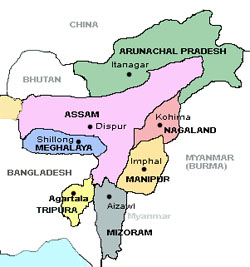Apr 17, 2024
Apr 17, 2024
 India's North Eastern States have been in varying state of turmoil for the last six decades. The seven states of Assam, Nagaland, Mizoram, Meghalaya, Manipur, Arunachal Pradesh and Tripura frequently referred to as the seven sisters, have had conflicts of varied intensities over the years. The roots of these have differed from state to state. However primarily these were related to tribalism, ethnic congruity and economic exploitation. The separation of Bangladesh (East Pakistan) in 1947 enhanced the divide by placing some states as Tripura and Mizoram at the other end of national geography, accessible through a circuitous route by rail and road. This increased the perception of alienation from the Indian heartland areas in the East, Bihar and Bengal. British Inner Line policy had added to the feeling of diversity amongst people of the North East.
India's North Eastern States have been in varying state of turmoil for the last six decades. The seven states of Assam, Nagaland, Mizoram, Meghalaya, Manipur, Arunachal Pradesh and Tripura frequently referred to as the seven sisters, have had conflicts of varied intensities over the years. The roots of these have differed from state to state. However primarily these were related to tribalism, ethnic congruity and economic exploitation. The separation of Bangladesh (East Pakistan) in 1947 enhanced the divide by placing some states as Tripura and Mizoram at the other end of national geography, accessible through a circuitous route by rail and road. This increased the perception of alienation from the Indian heartland areas in the East, Bihar and Bengal. British Inner Line policy had added to the feeling of diversity amongst people of the North East.
However over the years, peace seems to be gradually returning to many areas of the region through enlightened policies of the government and greater interaction between the people of the region with the national mainstream. In some areas, the people are finally fed up with militancy as they see terrorists indulging in extortion and crime.
The reduction in the level of violence is more than evident from a review of the statistics which has indicated a drop of over one third in fatalities from 1515 in 2000 to 475 in 2005, a six year period. In 2005, except for Assam and Manipur the deaths were in double figures. It is only these two states which seem to spiral out of control as shown by the recent incident of a bomb blast in Guwahati, the capital of Assam which killed over 14 personnel.
In Assam dialogue between the Central Government and the ULFA sponsored by PCG ended in a stalemate in September. Operations were resumed by both sides which implied continued extortion and bomb attacks by the ULFA in stepped up violence. 44 People are reported to have died in the violence during the last one month after lifting of the cease fire. It was anticipated by the Army that the ULFA will launch sustained operations by consolidating during the cease fire phase. The estimates of ULFA cadres vary from 300 to 500 with approximately 200 being hard core. But this number is adequate to create sporadic mayhem in the state.
There are groups and factions within groups which are capable of unrestricted violence. Manipur has its own dynamics, which represents the divisions in the society between the Meitis and the non Meitis, the Valley and non Valley people and so on. The main agitation at present is based on abolition of the Armed Forces Special Powers Act. It is evident that this hugely unpopular Act is the cause of much rancor in Manipur. The Manorama incident as well as the continued fast by Irom Sharmila has highlighted the importance of this issue. There is no doubt that there are vested interests fanned by militants who are involved in this agitation. However the state needs to take and enlightened view of the issue and evolve a paradigm which will satisfy the needs of the Army and the para military forces as well as provide some relief to the common people, without giving away the initiative to the militants. Such a solution should not be far to seek if all parties to the issue are willing to sit across the table and thrash out a logical formula.
The reported proposal by Mr Montek Sing Ahluwalia, Deputy Chairman of the Planning Commission to start North East centric airlines with low capacity aircraft such as the Dornier 228 which is being manufactured by HAL could bring some relief to the people and boost the economy. This will have to be supplemented by initiatives in tourism and allied services so that adequate spin offs are generated. The Dornier 228 has ideal capacity of 19, and can land on under prepared strips connecting the 18 airports quite adequately. The proposal will also relieve the mainstream airlines from flying to these areas. A North East Airlines could be created with a corpus from the centre with experts from the air lines industry to assess its viability, selecting the most suitable aircraft and ensuring early implementation. However this is likely to reach only the creamy layer. There needs to be a slew of measures which can integrate the people of the region at the bottom of the pyramid with the mainstream.
The Central government's Look East policy has led to greater attention being devoted to the problems of the region. The Civil society in the area is quite active. Roads to Myanmar are likely to open shortly. This will reestablish the link of the region with Myanmar, while some old soldiers will seek to revive memories of the Burma Campaign. On the whole it appears that the North East is emerging as another idyllic spot for visitors.
12-Nov-2006
More by : Col. Rahul K. Bhonsle